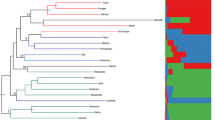Abstract
Buffalograss [Buchloe dactyloides (Nutt.) Englem] germplasm has a broad resource of genetic diversity that can be used for turfgrass, forage and conservation. Buffalograss is the only native grass that is presently used as a turfgrass in the Great Plains region of North America. Its low growth habit, drought tolerance and reduced requirement for fertilizer and pesticides contribute to interest in its use. The objectives of this study were to use sequence-related amplified polymorphism (SRAP) markers in the evaluation of genetic diversity and phenetic relationships in a diverse collection of 53 buffalograss germplasms, and to identify buffalograss ploidy levels using flow cytometry. Based on their DNA contents, buffalograss genotypes were grouped into four sets, corresponding to their ploidy levels. Thirty-four SRAP primer combinations were used. This is the first report of the detection of differentiating diploid, tetraploid, pentaploid and hexaploid buffalograss genotypes, representing diverse locations of origin, using SRAP markers. Cluster analysis by the unweighted pair-group method with arithmetic averages based on genetic similarity matrices indicated that there were eight clusters. The coefficients of genetic distance among the genotypes ranged from 0.33 up to 0.99 and averaged D=0.66. The genetic diversity estimate, He, averaged 0.35. These results demonstrated that genotypes with potential traits for turfgrass improvement could readily be distinguished, based on SRAP. The use of PCR-based technologies such as SRAP is an effective tool for estimating genetic diversity, identifying unique genotypes as new sources of alleles for enhancing turf characteristics, and for analyzing the evolutionary and historical development of cultivars at the genomic level in a buffalograss breeding program.



Similar content being viewed by others
References
Arumuganathan K, Earl ED (1991) Estimation of nuclear DNA contents of plants by flow cytometry. Plant Mol Biol Rep 9:229–241
Beetle AA (1950) Buffalograss-native of the shortgrass plains. Univ Wyoming Agric Exp Stn Bull 293
Ferriol M, Pico B, Nuez F (2003) Genetic diversity of a germplasm collection of Cucurbita pepo using SRAP and AFLP markers. Theor Appl Genet 107:271–282
Godelle B, Cartier D, Marie D, Brown SC, Siljak-Yakovlev S (1993) Heterochromatin study demonstrating the non-linearity of fluorometry useful for calculating genomic base composition. Cytometry 14:618–626
Huff DR, Peakall R, Smouse PE (1993) RAPD variation within and among natural populations of outcrossing buffalograss [Buchloe dactyloides (Nutt.) Engelm.]. Theor Appl Genet 86:927–934
Johnson PG, Riordan TP, Arumuganathan K (1998) Ploidy level determinations in buffalograss clones and populations. Crop Sci 38:478–482
Johnson PG, Kenworthy KE, Auld DL, Riordan TP (2001) Distribution of buffalograss polyploid variation in the southern Great Plains. Crop Sci 41 909–913
Karaca M, Saha S, Zipf A, Jenkins JN, Lang DJ (2002) Genetic diversity among forage bermudagrass (Cynodon spp.): evidence from chloroplast and nuclear DNA fingerprinting. Crop Sci 42:2118–2127
Li G, Quiros CF (2001) Sequence-related amplified polymorphism (SRAP) a new marker system based on a simple PCR reaction: its application to mapping and gene tagging in Brassica. Theor Appl Genet 103:455–461
Nei M, Li WH (1979) Mathematical model for studying genetic variation in terms of restriction endonucleases. Proc Natl Acad Sci USA 76:5269–5273
Peakall R, Smouse PE, Huff DR (1995) Evolutionary implications of allozyme and RAPD variation in diploid populations of dioecious buffalograss Buchloe dactyloides. Mol Ecol 4:135–147
Reeder JR (1971) Notes on Mexican grasses. IX. Miscellaneous chromosome numbers. Brittonia 23:105–117
Riordan TP, de Shazer SA, Johnson-Cicalese JM, Shearman RC (1993) An overview of breeding and development of buffalograss. Int Turfgrass Soc Res J 7:816–822
Roodt R, Spies JJ, Burger TH (2002) Preliminary DNA fingerprinting of the turfgrass Cynodon dactylon (Poaceae: Cloridoideae). Bothalia. 32:117–122
Sneath PHA, Sokal RR (1973) Numerical taxonomy. Freeman, San Francisco
Vos P, Hogers R, Bleeker M, Reijans M, van de Lee T, Hornes M, Frijters A, Pot J, Peleman J, Kuiper M, Zabeau M (1995) AFLP: a new technique for DNA fingerprinting. Nucleic Acids Res 23:4407–4414
Wagner DB, Furnier MA, Saghai-Maroof SA, Williams SM, Dancik BP, Allard RW (1987) Chloroplast DNA polymorphisms in lodgepole and jack pines and their hybrids. Proc Natl Acad Sci USA 84:2097–2100
Welsh J, McClelland M (1990) Fingerprinting genomes using PCR with arbitrary primers. Nucleic Acids Res 18:7213–7218
Wu L, Lin H (1994) Identifying buffalograss [Buchloe dactyloides (Nutt.) Engelm.] cultivar breeding lines using random amplified polymorphic DNA (RAPD) markers. J Am Soc Hort Sci 119:126–130
Zhang LH, Ozias-Akins P, Kochert G, Kresovich S, Dean R, Hanna W (1999) Differentiation of bermudagrass (Cynodon spp.) genotypes by AFLP analyses. Theor Appl Genet 98:895–902
Acknowledgements
This work was supported in part by the Nebraska Turfgrass Association. The authors thank Drs. P. Stephen Baenziger and Lowell E. Moser for their critical review and suggestions to improve this manuscript.
Author information
Authors and Affiliations
Corresponding author
Additional information
Communicated by B. Friebe
Rights and permissions
About this article
Cite this article
Budak, H., Shearman, R.C., Parmaksiz, I. et al. Molecular characterization of Buffalograss germplasm using sequence-related amplified polymorphism markers. Theor Appl Genet 108, 328–334 (2004). https://doi.org/10.1007/s00122-003-1428-4
Received:
Accepted:
Published:
Issue Date:
DOI: https://doi.org/10.1007/s00122-003-1428-4




